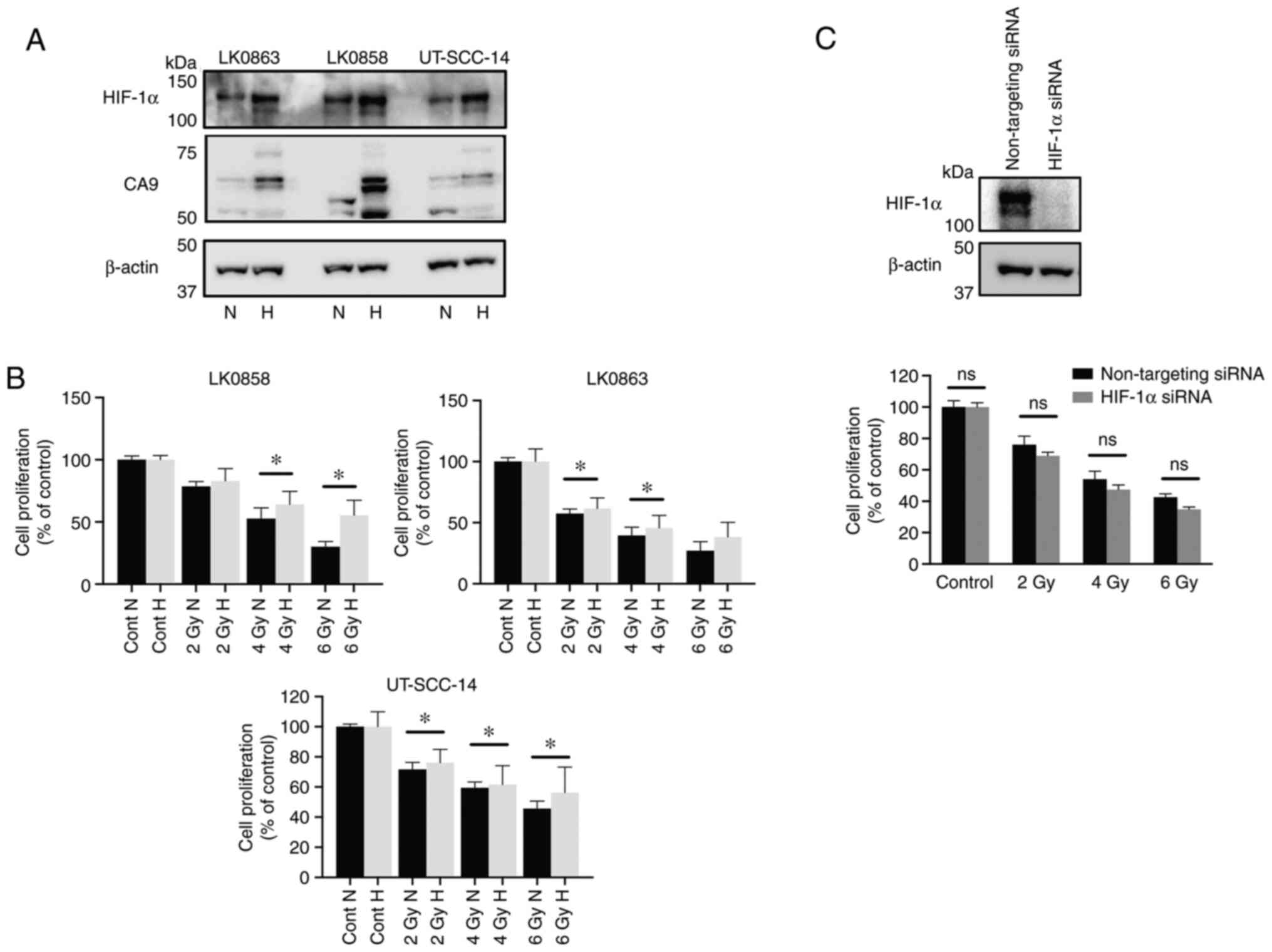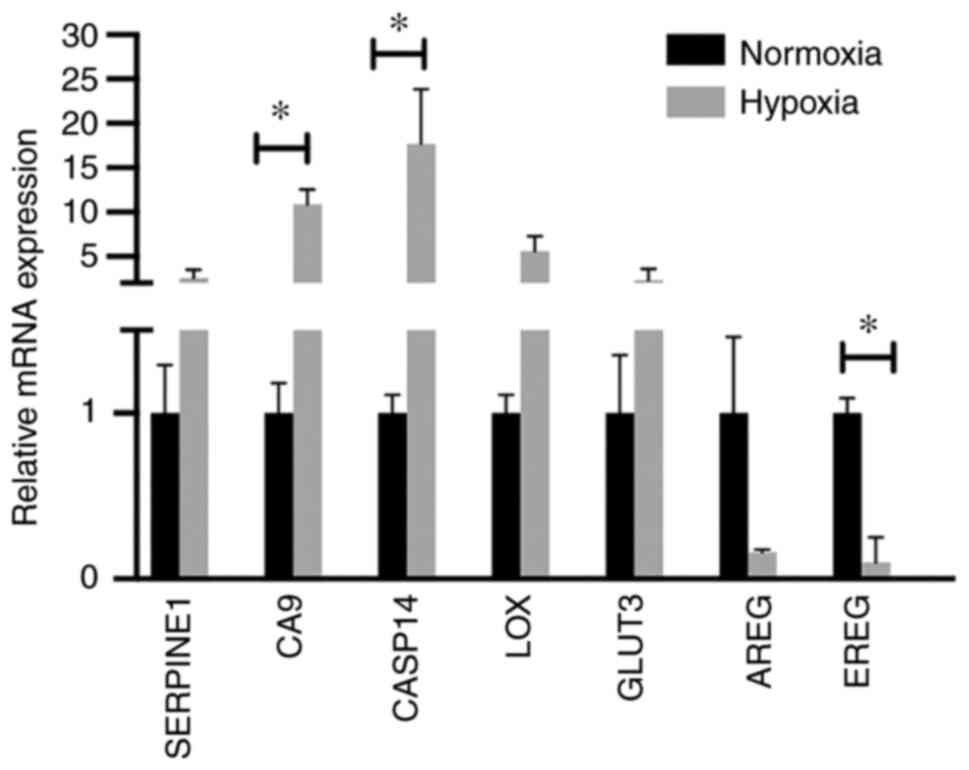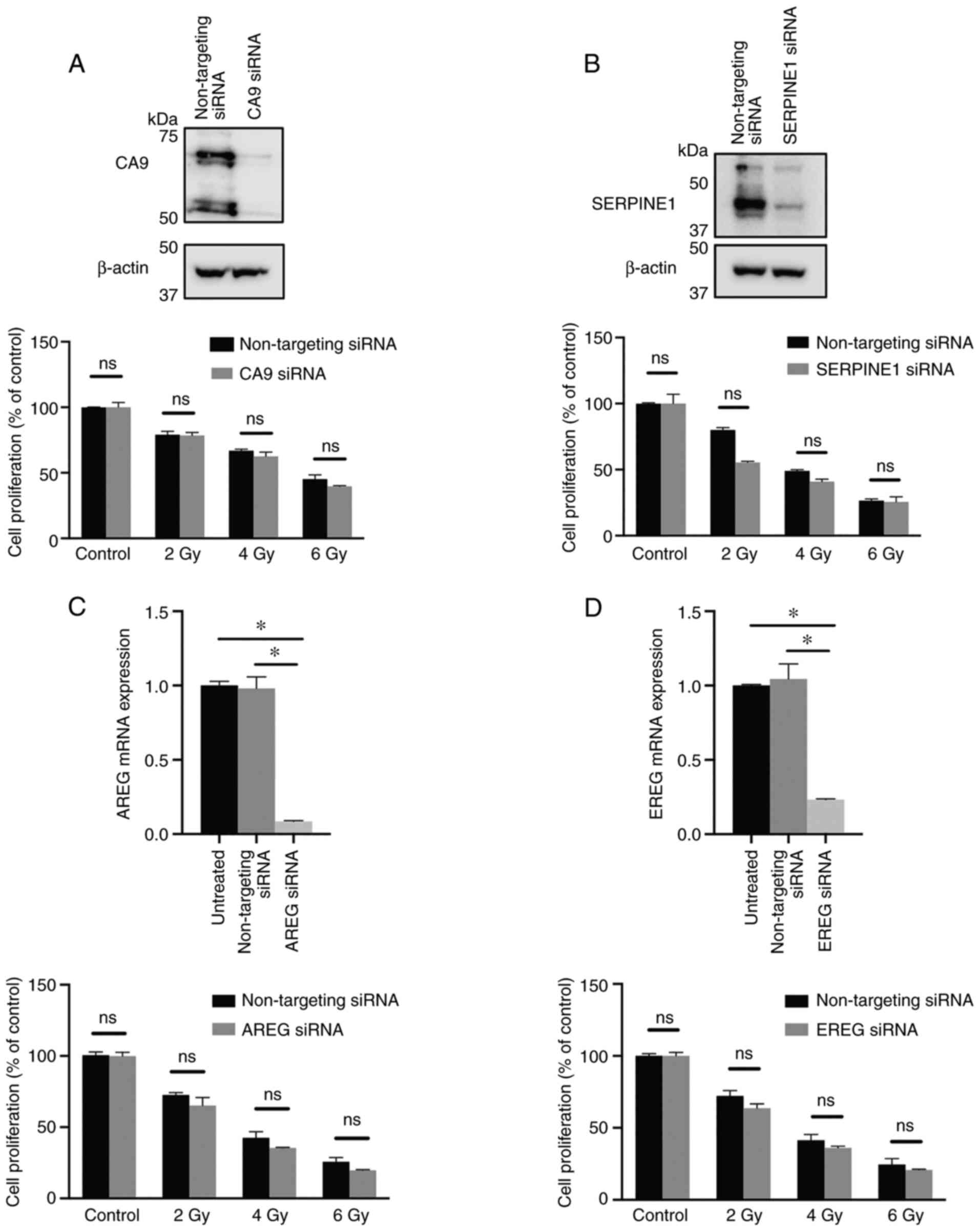|
1
|
Torre LA, Bray F, Siegel RL, Ferlay J,
Lortet-Tieulent J and Jemal A: Global cancer statistics, 2012. CA
Cancer J Clin. 65:87–108. 2015. View Article : Google Scholar : PubMed/NCBI
|
|
2
|
Saman DM: A review of the epidemiology of
oral and pharyngeal carcinoma: Update. Head Neck Oncol. 4:12012.
View Article : Google Scholar : PubMed/NCBI
|
|
3
|
Koukourakis G, Kouloulias V, Koukourakis
M, Kouvaris J, Zacharias G and Gouliamos A: The efficacy of
combined treatment with cetuximab (erbitux) and radiation therapy
in patients with head and neck cancer. J BUON. 14:19–25.
2009.PubMed/NCBI
|
|
4
|
Pulte D and Brenner H: Changes in survival
in head and neck cancers in the late 20th and early 21st century: A
period analysis. Oncologist. 15:994–1001. 2010. View Article : Google Scholar : PubMed/NCBI
|
|
5
|
Alsahafi E, Begg K, Amelio I, Raulf N,
Lucarelli P, Sauter T and Tavassoli M: Clinical update on head and
neck cancer: Molecular biology and ongoing challenges. Cell Death
Dis. 10:5402019. View Article : Google Scholar : PubMed/NCBI
|
|
6
|
Bredell MG, Ernst J, El-Kochairi I, Dahlem
Y, Ikenberg K and Schumann DM: Current relevance of hypoxia in head
and neck cancer. Oncotarget. 7:50781–50804. 2016. View Article : Google Scholar : PubMed/NCBI
|
|
7
|
Lv X, Li J, Zhang C, Hu T, Li S, He S, Yan
H, Tan Y, Lei M, Wen M and Zuo J: The role of hypoxia-inducible
factors in tumor angiogenesis and cell metabolism. Genes Dis.
4:19–24. 2016. View Article : Google Scholar : PubMed/NCBI
|
|
8
|
Salceda S and Caro J: Hypoxia-inducible
factor 1alpha (HIF-1alpha) protein is rapidly degraded by the
ubiquitin-proteasome system under normoxic conditions. Its
stabilization by hypoxia depends on redox-induced changes. J Biol
Chem. 272:22642–22647. 1997. View Article : Google Scholar : PubMed/NCBI
|
|
9
|
Semenza GL: Defining the role of
hypoxia-inducible factor 1 in cancer biology and therapeutics.
Oncogene. 29:625–634. 2010. View Article : Google Scholar : PubMed/NCBI
|
|
10
|
Koukourakis MI, Giatromanolaki A, Sivridis
E, Simopoulos C, Turley H, Talks K, Gatter KC and Harris AL:
Hypoxia-inducible factor (HIF1A and HIF2A), angiogenesis, and
chemoradiotherapy outcome of squamous cell head-and-neck cancer.
Int J Radiat Oncol Biol Phys. 53:1192–1202. 2002. View Article : Google Scholar : PubMed/NCBI
|
|
11
|
Al Tameemi W, Dale TP, Al-Jumaily RMK and
Forsyth NR: Hypoxia-modified cancer cell metabolism. Front Cell Dev
Biol. 7:42019. View Article : Google Scholar : PubMed/NCBI
|
|
12
|
Luoto KR, Kumareswaran R and Bristow RG:
Tumor hypoxia as a driving force in genetic instability. Genome
Integr. 4:52013. View Article : Google Scholar : PubMed/NCBI
|
|
13
|
Rankin EB, Nam JM and Giaccia AJ: Hypoxia:
Signaling the metastatic cascade. Trends Cancer. 2:295–304. 2016.
View Article : Google Scholar : PubMed/NCBI
|
|
14
|
Erler JT, Bennewith KL, Nicolau M,
Dornhöfer N, Kong C, Le QT, Chi JT, Jeffrey SS and Giaccia AJ:
Lysyl oxidase is essential for hypoxia-induced metastasis. Nature.
440:1222–1226. 2006. View Article : Google Scholar : PubMed/NCBI
|
|
15
|
Burroughs SK, Kaluz S, Wang D, Wang K, Van
Meir EG and Wang B: Hypoxia inducible factor pathway inhibitors as
anticancer therapeutics. Future Med Chem. 5:553–572. 2013.
View Article : Google Scholar : PubMed/NCBI
|
|
16
|
Perri F, Pacelli R, Della Vittoria
Scarpati G, Cella L, Giuliano M, Caponigro F and Pepe S:
Radioresistance in head and neck squamous cell carcinoma:
Biological bases and therapeutic implications. Head Neck.
37:763–770. 2015. View Article : Google Scholar : PubMed/NCBI
|
|
17
|
Higgins GS, O'Cathail SM, Muschel RJ and
McKenna WG: Drug radiotherapy combinations: Review of previous
failures and reasons for future optimism. Cancer Treat Rev.
41:105–113. 2015. View Article : Google Scholar : PubMed/NCBI
|
|
18
|
Dudas J, Ladanyi A, Ingruber J,
Steinbichler TB and Riechelmann H: Epithelial to mesenchymal
transition: A mechanism that fuels cancer radio/chemoresistance.
Cells. 9:4282020. View Article : Google Scholar : PubMed/NCBI
|
|
19
|
Yeo CD, Kang N, Choi SY, Kim BN, Park CK,
Kim JW, Kim YK and Kim SJ: The role of hypoxia on the acquisition
of epithelial-mesenchymal transition and cancer stemness: A
possible link to epigenetic regulation. Korean J Intern Med.
32:589–599. 2017. View Article : Google Scholar : PubMed/NCBI
|
|
20
|
Hsieh JC, Wang HM, Wu MH, Chang KP, Chang
PH, Liao CT and Liau CT: Review of emerging biomarkers in head and
neck squamous cell carcinoma in the era of immunotherapy and
targeted therapy. Head Neck. 41 (Suppl 1):S19–S45. 2019. View Article : Google Scholar : PubMed/NCBI
|
|
21
|
Swartz JE, Pothen AJ, Stegeman I, Willems
SM and Grolman W: Clinical implications of hypoxia biomarker
expression in head and neck squamous cell carcinoma: A systematic
review. Cancer Med. 4:1101–1116. 2015. View Article : Google Scholar : PubMed/NCBI
|
|
22
|
Koukourakis MI, Giatromanolaki A, Sivridis
E, Simopoulos K, Pastorek J, Wykoff CC, Gatter KC and Harris AL:
Hypoxia-regulated carbonic anhydrase-9 (CA9) relates to poor
vascularization and resistance of squamous cell head and neck
cancer to chemoradiotherapy. Clin Cancer Res. 7:3399–3403.
2001.PubMed/NCBI
|
|
23
|
Russo G, Zegar C and Giordano A:
Advantages and limitations of microarray technology in human
cancer. Oncogene. 22:6497–6507. 2003. View Article : Google Scholar : PubMed/NCBI
|
|
24
|
Kurahashi I, Fujita Y, Arao T, Kurata T,
Koh Y, Sakai K, Matsumoto K, Tanioka M, Takeda K, Takiguchi Y, et
al: A microarray-based gene expression analysis to identify
diagnostic biomarkers for unknown primary cancer. PLoS One.
8:e632492013. View Article : Google Scholar : PubMed/NCBI
|
|
25
|
Jedlinski A, Ansell A, Johansson AC and
Roberg K: EGFR status and EGFR ligand expression influence the
treatment response of head and neck cancer cell lines. J Oral
Pathol Med. 42:26–36. 2013. View Article : Google Scholar : PubMed/NCBI
|
|
26
|
Livak KJ and Schmittgen TD: Analysis of
relative gene expression data using real-time quantitative PCR and
the 2(−Delta Delta C(T)) method. Methods. 25:402–408. 2001.
View Article : Google Scholar : PubMed/NCBI
|
|
27
|
Irizarry RA, Hobbs B, Collin F,
Beazer-Barclay YD, Antonellis KJ, Scherf U and Speed TP:
Exploration, normalization, and summaries of high density
oligonucleotide array probe level data. Biostatistics. 4:249–264.
2003. View Article : Google Scholar : PubMed/NCBI
|
|
28
|
Ritchie ME, Phipson B, Wu D, Hu Y, Law CW,
Shi W and Smyth GK: Limma powers differential expression analyses
for RNA-sequencing and microarray studies. Nucleic Acids Res.
43:e472015. View Article : Google Scholar : PubMed/NCBI
|
|
29
|
Wiechec E, Hansson KT, Alexandersson L,
Jonsson JI and Roberg K: Hypoxia mediates differential response to
Anti-EGFR therapy in HNSCC cells. Int J Mol Sci. 18:9432017.
View Article : Google Scholar : PubMed/NCBI
|
|
30
|
Muz B, de la Puente P, Azab F and Azab AK:
The role of hypoxia in cancer progression, angiogenesis,
metastasis, and resistance to therapy. Hypoxia (Auckl). 3:83–92.
2015. View Article : Google Scholar : PubMed/NCBI
|
|
31
|
Sorensen BS and Horsman MR: Tumor hypoxia:
Impact on radiation therapy and molecular pathways. Front Oncol.
10:5622020. View Article : Google Scholar : PubMed/NCBI
|
|
32
|
Sebestyen A, Kopper L, Danko T and Timar
J: Hypoxia signaling in cancer: From basics to clinical practice.
Pathol Oncol Res. 27:16098022021. View Article : Google Scholar : PubMed/NCBI
|
|
33
|
Isa AY, Ward TH, West CM, Slevin NJ and
Homer JJ: Hypoxia in head and neck cancer. Br J Radiol. 79:791–798.
2006. View Article : Google Scholar : PubMed/NCBI
|
|
34
|
Swartz JE, Pothen AJ, van Kempen PM,
Stegeman I, Formsma FK, Cann EM, Willems SM and Grolman W: Poor
prognosis in human papillomavirus-positive oropharyngeal squamous
cell carcinomas that overexpress hypoxia inducible factor-1α. Head
Neck. 38:1338–1346. 2016. View Article : Google Scholar : PubMed/NCBI
|
|
35
|
Harada H: Hypoxia-inducible factor
1-mediated characteristic features of cancer cells for tumor
radioresistance. J Radiat Res. 57 (Suppl 1):i99–i105. 2016.
View Article : Google Scholar : PubMed/NCBI
|
|
36
|
Moeller BJ and Dewhirst MW: HIF-1 and
tumour radiosensitivity. Br J Cancer. 95:1–5. 2006. View Article : Google Scholar : PubMed/NCBI
|
|
37
|
Harada H, Itasaka S, Zhu Y, Zeng L, Xie X,
Morinibu A, Shinomiya K and Hiraoka M: Treatment regimen determines
whether an HIF-1 inhibitor enhances or inhibits the effect of
radiation therapy. Br J Cancer. 100:747–757. 2009. View Article : Google Scholar : PubMed/NCBI
|
|
38
|
Gu Q, He Y, Ji J, Yao Y, Shen W, Luo J,
Zhu W, Cao H, Geng Y, Xu J, et al: Hypoxia-inducible factor 1α
(HIF-1α) and reactive oxygen species (ROS) mediates
radiation-induced invasiveness through the SDF-1α/CXCR4 pathway in
non-small cell lung carcinoma cells. Oncotarget. 6:10893–10907.
2015. View Article : Google Scholar : PubMed/NCBI
|
|
39
|
Moeller BJ, Cao Y, Li CY and Dewhirst MW:
Radiation activates HIF-1 to regulate vascular radiosensitivity in
tumors: Role of reoxygenation, free radicals, and stress granules.
Cancer Cell. 5:429–441. 2004. View Article : Google Scholar : PubMed/NCBI
|
|
40
|
Thierauf J, Veit JA and Hess J:
Epithelial-to-Mesenchymal transition in the pathogenesis and
therapy of head and neck cancer. Cancers (Basel). 9:762017.
View Article : Google Scholar : PubMed/NCBI
|
|
41
|
Jerhammar F, Ceder R, Garvin S, Grenman R,
Grafstrom RC and Roberg K: Fibronectin 1 is a potential biomarker
for radioresistance in head and neck squamous cell carcinoma.
Cancer Biol Ther. 10:1244–1251. 2010. View Article : Google Scholar : PubMed/NCBI
|
|
42
|
Derycke LD and Bracke ME: N-cadherin in
the spotlight of cell-cell adhesion, differentiation,
embryogenesis, invasion and signalling. Int J Dev Biol. 48:463–476.
2004. View Article : Google Scholar : PubMed/NCBI
|
|
43
|
Toustrup K, Sorensen BS, Alsner J and
Overgaard J: Hypoxia gene expression signatures as prognostic and
predictive markers in head and neck radiotherapy. Semin Radiat
Oncol. 22:119–127. 2012. View Article : Google Scholar : PubMed/NCBI
|
|
44
|
Yang L and West CM: Hypoxia gene
expression signatures as predictive biomarkers for personalising
radiotherapy. Br J Radiol. 92:201800362019.PubMed/NCBI
|
|
45
|
Toustrup K, Sørensen BS, Nordsmark M, Busk
M, Wiuf C, Alsner J and Overgaard J: Development of a hypoxia gene
expression classifier with predictive impact for hypoxic
modification of radiotherapy in head and neck cancer. Cancer Res.
71:5923–5931. 2011. View Article : Google Scholar : PubMed/NCBI
|
|
46
|
Sung FL, Hui EP, Tao Q, Li H, Tsui NB, Lo
YM, Ma BB, To KF, Harris AL and Chan AT: Genome-wide expression
analysis using microarray identified complex signaling pathways
modulated by hypoxia in nasopharyngeal carcinoma. Cancer Lett.
253:74–88. 2007. View Article : Google Scholar : PubMed/NCBI
|
|
47
|
Beasley NJ, Wykoff CC, Watson PH, Leek R,
Turley H, Gatter K, Pastorek J, Cox GJ, Ratcliffe P and Harris AL:
Carbonic anhydrase IX, an endogenous hypoxia marker, expression in
head and neck squamous cell carcinoma and its relationship to
hypoxia, necrosis, and microvessel density. Cancer Res.
61:5262–5267. 2001.PubMed/NCBI
|
|
48
|
Wykoff CC, Beasley NJ, Watson PH, Turner
KJ, Pastorek J, Sibtain A, Wilson GD, Turley H, Talks KL, Maxwell
PH, et al: Hypoxia-inducible expression of tumor-associated
carbonic anhydrases. Cancer Res. 60:7075–7083. 2000.PubMed/NCBI
|
|
49
|
Handa T, Katayama A, Yokobori T, Yamane A,
Horiguchi J, Kawabata-Iwakawa R, Rokudai S, Bao P, Gombodorj N,
Altan B, et al: Caspase14 expression is associated with triple
negative phenotypes and cancer stem cell marker expression in
breast cancer patients. J Surg Oncol. 116:706–715. 2017. View Article : Google Scholar : PubMed/NCBI
|
|
50
|
Keleg S, Kayed H, Jiang X, Penzel R, Giese
T, Büchler MW, Friess H and Kleeff J: Adrenomedullin is induced by
hypoxia and enhances pancreatic cancer cell invasion. Int J Cancer.
121:21–32. 2007. View Article : Google Scholar : PubMed/NCBI
|
|
51
|
Erler JT, Bennewith KL, Cox TR, Lang G,
Bird D, Koong A, Le QT and Giaccia AJ: Hypoxia-induced lysyl
oxidase is a critical mediator of bone marrow cell recruitment to
form the premetastatic niche. Cancer Cell. 15:35–44. 2009.
View Article : Google Scholar : PubMed/NCBI
|
|
52
|
Liu W, Shen SM, Zhao XY and Chen GQ:
Targeted genes and interacting proteins of hypoxia inducible
factor-1. Int J Biochem Mol Biol. 3:165–178. 2012.PubMed/NCBI
|
|
53
|
Ayala FR, Rocha RM, Carvalho KC, Carvalho
AL, da Cunha IW, Lourenço SV and Soares FA: GLUT1 and GLUT3 as
potential prognostic markers for oral squamous cell carcinoma.
Molecules. 15:2374–2387. 2010. View Article : Google Scholar : PubMed/NCBI
|
|
54
|
Benej M, Pastorekova S and Pastorek J:
Carbonic anhydrase IX: Regulation and role in cancer. Subcell
Biochem. 75:199–219. 2014. View Article : Google Scholar : PubMed/NCBI
|
|
55
|
Kwon OJ, Park JJ, Ko GH, Seo JH, Jeong BK,
Kang KM, Woo SH, Kim JP, Hwa JS and Carey TE: HIF-1α and CA-IX as
predictors of locoregional control for determining the optimal
treatment modality for early-stage laryngeal carcinoma. Head Neck.
37:505–510. 2015. View Article : Google Scholar : PubMed/NCBI
|
|
56
|
Hwa JS, Kwon OJ, Park JJ, Woo SH, Kim JP,
Ko GH, Seo JH and Kim RB: The prognostic value of
immunohistochemical markers for oral tongue squamous cell
carcinoma. Eur Arch Otorhinolaryngol. 272:2953–2959. 2015.
View Article : Google Scholar : PubMed/NCBI
|
|
57
|
Eriksen JG and Overgaard J; Danish Head
and Neck Cancer Study Group (DAHANCA), . Lack of prognostic and
predictive value of CA IX in radiotherapy of squamous cell
carcinoma of the head and neck with known modifiable hypoxia: An
evaluation of the DAHANCA 5 study. Radiother Oncol. 83:383–388.
2007. View Article : Google Scholar : PubMed/NCBI
|
|
58
|
Lee YC, Yu CC, Lan C, Lee CH, Lee HT, Kuo
YL, Wang PH and Chang WW: Plasminogen activator inhibitor-1 as
regulator of tumor-initiating cell properties in head and neck
cancers. Head Neck. 38 (Suppl 1):E895–E904. 2016. View Article : Google Scholar : PubMed/NCBI
|
|
59
|
Pavon MA, Arroyo-Solera I, Cespedes MV,
Casanova I, Leon X and Mangues R: uPA/uPAR and SERPINE1 in head and
neck cancer: Role in tumor resistance, metastasis, prognosis and
therapy. Oncotarget. 7:57351–57366. 2016. View Article : Google Scholar : PubMed/NCBI
|
|
60
|
Bayer C, Schilling D, Hoetzel J, Egermann
HP, Zips D, Yaromina A, Geurts-Moespot A, Sprague LD, Sweep F,
Baumann M, et al: PAI-1 levels predict response to fractionated
irradiation in 10 human squamous cell carcinoma lines of the head
and neck. Radiother Oncol. 86:361–368. 2008. View Article : Google Scholar : PubMed/NCBI
|
|
61
|
Busser B, Sancey L, Brambilla E, Coll JL
and Hurbin A: The multiple roles of amphiregulin in human cancer.
Biochim Biophys Acta. 1816:119–131. 2011.PubMed/NCBI
|
|
62
|
Cluckey A, Perino AC, Yunus FN, Leef GC,
Askari M, Heidenreich PA, Narayan SM, Wang PJ and Turakhia MP:
Efficacy of ablation lesion sets in addition to pulmonary vein
isolation for paroxysmal atrial fibrillation: Findings from the
SMASH-AF meta-analysis study cohort. J Am Heart Assoc.
8:e0099762019. View Article : Google Scholar : PubMed/NCBI
|


















